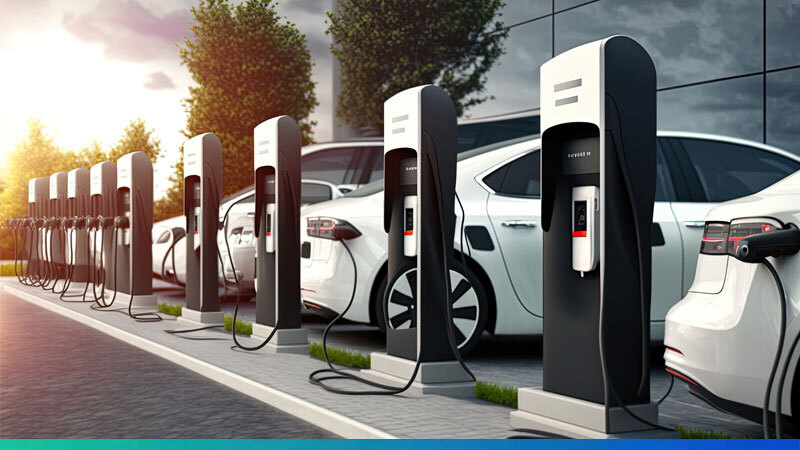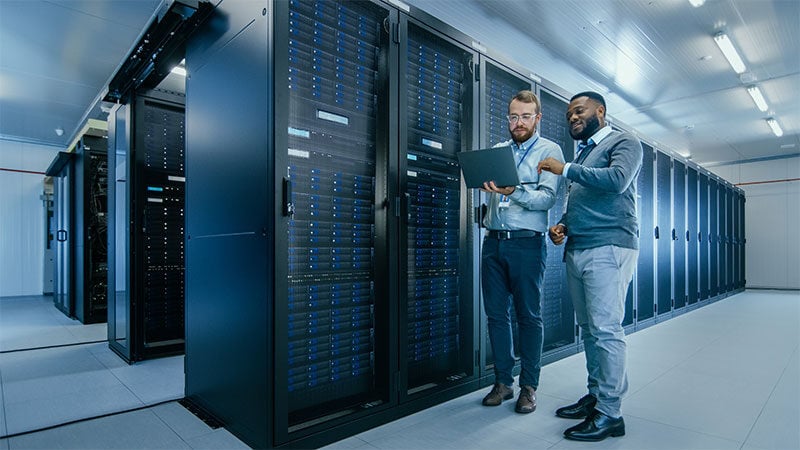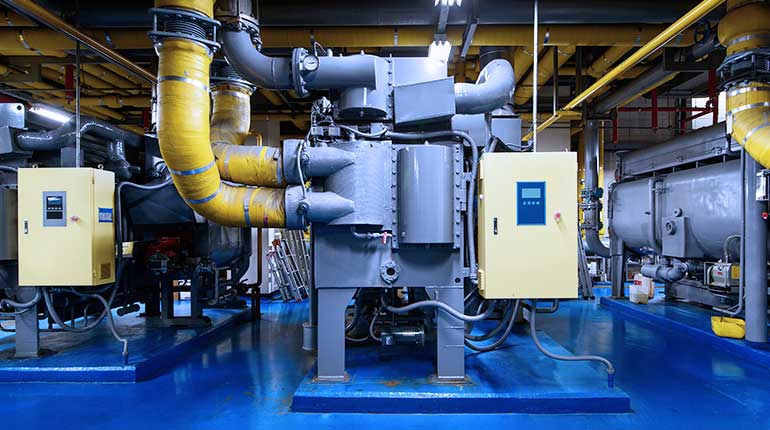INNIO Jenbacher's Design Process with Xendee
View how INNIO Jenbacher uses Xendee during their design process to integrate combined heat and power (CHP) with renewables to create robust...
Integrating absorption chillers with combined heat and power (CHP) systems enables next-generation microgrids, especially in data centers and hospitals, to achieve significantly lower emissions, reduced energy costs, and greater resilience by transforming waste heat into efficient, electricity-free cooling.
Introduction
For commercial, industrial, or campus-scale distributed energy systems or microgrids, the focus is typically on the demand and supply of electricity. Power is the core product being created and spent in these systems, but in order to achieve the lowest costs and highest efficiency, it’s important to view the project more holistically by also considering heating and cooling as important opportunities.
For example, in addition to having adequate power supply, data centers come with an additional significant challenge—keeping the facility cool. The high-performance servers and equipment generate large amounts of heat as a byproduct of computation, which demands constant cooling to ensure their reliability and performance.
Cooling these facilities with electric chillers can require high volumes of electricity, driving up operational costs. But what if there was a more efficient and less electricity-intensive way to keep data centers and other facilities cool?
By combining the right technologies in the optimal way, cooling efficiency can be greatly improved. Two of these technologies are Combined Heat and Power (CHP) and absorption chillers. Although CHP is commonly used in commercial microgrid applications, absorption chillers are perhaps an underutilized opportunity relative to their unique benefits.
Leveraging Absorption Chillers
Absorption chillers are not just niche components. In today’s energy landscape, they are proving essential in high-performance microgrids by turning low-grade or waste heat into valuable cooling. This reduces electricity use, creates lower carbon emissions, and enhances resilience. This blog combines market insights, case studies, and Xendee modeling strategies to help improve the financial and environmental outcomes of your next microgrid or DER project.
Absorption Chiller Market Snapshot: Rising Adoption
Recent reports from Coherent Market Insights show steady global market growth, driven by decarbonization, high electricity costs, and policy support.

Figure 1. Global absorption chiller market growth (2025–2032), Compound Annual Growth Rate (CAGR): 5.3% [1].
Key Growth Drivers
Market Challenges
Although there are multiple benefits that can be achieved by incorporating absorption chillers into a microgrid, there are also some disadvantages that need to weigh into the decision. Absorption chillers can come with higher upfront capital costs than electric chillers, in some cases nearly double the cost for installed units [2]. And they can also require specialized operation and maintenance expertise to manage vacuum integrity, preventing crystallization, and water treatment, making them harder to maintain and potentially making it harder to have skilled staff with the right capabilities.
How Absorption Chillers Work
Absorption chillers use heat instead of electricity to produce chilled water. To accomplish this, a lithium bromide or ammonia solution circulates through a cycle of evaporator, absorber, generator, and condenser. Common heat sources include CHP exhaust, Solar thermal, and Biogas or industrial waste heat. Removing electric compressors significantly reduces power demand.

Figure 2. Graphical representation of the electric load for the data center considered in this study for a typical year. For privacy reasons the scales are removed. Note that the absorption chiller whose internal hardware is the (1) Generator > (2) Condenser > (3) Evaporator > (4) Absorber loop, consumes that thermal resource to make chilled water.
Performance Benefits in Microgrid Deployments
For commercial microgrid deployments, there are several benefits of absorption chillers that make them attractive technologies to include.

Strategic Applications for Absorption Chillers
Because of the above benefits, absorption chillers bring strategic benefits to data centers where waste heat can be reused to improve efficiency, hospitals can have continuous cooling from CHP/fuel cells, cold storage operations can convert engine exhaust into cooling, and campuses can integrate CHP and thermal storage.
Let’s take a look at a couple of real examples.
Case 1 – Southern California Hospital Campus (Published Mar 2023)
343-ton (1.2 MW) LiBr absorption chiller | 2 × 1.5 MW CHP generators
Case 2 – Minnesota Data Center (Operational since 2017):
200-ton (700 kW) abs chiller | 600 kW microturbine + 150 kW rooftop PV + 24kW Wind turbines + BESS
Modeling Absorption Chillers in Xendee - Data Center Scenarios
For commercial microgrid deployments, there are several benefits of absorption chillers that make them attractive technologies to include.
We used a real Data Center profile (electric and cooling) to evaluate three scenarios, which illustrate the difference in outcomes such as costs and emissions. (Appendix 1 details load, financing, and fuel cost inputs.)
In the table below, you can see the results of running the optimization for each of these scenarios. The addition of the absorption chiller achieved 20.2% total savings (considering also the investment costs) relative to the base case, and doubled the total savings (considering also the investment costs) achieved (10.4%) with just adding CHP alone. And by adding the absorption chiller, a 21.4% reduction in CO2 was achieved relative to the base case, which is over triple the benefit (6.2%) of just adding CHP alone.
In summary, absorption chillers, especially with CHP integration, enable more cost-effective, resilient, and low-emissions cooling for next-generation microgrids.

Appendix
This appendix summarizes the key technical and financial inputs (including load, financing, and fuel cost inputs) used to model the absorption chiller scenarios in Xendee.



References:
[1] Coherent Market Insights, Absorption Chillers Market Analysis & Forecast: 2025–2032. Report Code: CMI1464, February 2025. [Online]. Available: https://www.coherentmarketinsights.com/market-insight/absorption-chiller-market-1464/market-size-and-trends
[2] U.S. Energy Information Administration, Updated Buildings Sector Appliance and Equipment Costs and Efficiencies, [Online]. Available: https://www.eia.gov/analysis/studies/buildings/equipcosts/pdf/full.pdf Abs Chiller: Commercial Gas‑Fired Chillers (Water‑Cooled, Direct‑Fired Only) – p. 133 of 858, rows “Total Installed Cost”. And Electric Chiller: Commercial Centrifugal Chillers (Water‑Cooled) – p. 125 of 858, same row.
[3] U.S. Energy Information Administration, U.S. Natural Gas Citygate Price, [Online]. Available: https://www.eia.gov/dnav/ng/hist/n3050us3m.htm
[4] U.S. Energy Information Administration, U.S. Price of Natural Gas Sold to Commercial Consumers, [Online]. Available: https://www.eia.gov/dnav/ng/hist/n3020us3m.htm and U.S. Energy Information Administration, United States Natural Gas Industrial Price, [Online]. Available: https://www.eia.gov/dnav/ng/hist/n3035us3m.htm
[5] U.S. Energy Information Administration, U.S. No 2 Diesel Retail Prices, [Online]. Available: https://www.eia.gov/dnav/pet/hist/LeafHandler.ashx?n=pet&s=emd_epd2d_pte_nus_dpg&f=m and U.S. Department of Energy, National Average Price, [Online]. Available: https://afdc.energy.gov/fuels/prices.html

View how INNIO Jenbacher uses Xendee during their design process to integrate combined heat and power (CHP) with renewables to create robust...

The National Electric Vehicle Infrastructure (NEVI) program is a federally funded program that aims to allocate $5 billion over five years (2022 -...

The growing power demand of data centers driven by AI highlights the urgent need for sustainable energy solutions, with Microgrids and Distributed...
